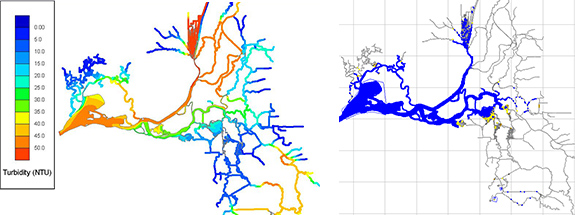Featured Projects — Modeling Turbidity and Delta Smelt Forecast Modeling
During winter storm events, the combination of turbid river inflows, antecedent conditions, and Delta operations has the potential to create conditions leading to high delta smelt salvage at the State Water Project and Central Valley Project pumping facilities in the southern Delta. In order to better predict these events and initiate timely operational changes aimed at mitigating them, RMA was contracted by the Metropolitan Water District of Southern California (MWD) to model storm event hydrodynamic and water quality conditions, and the resulting delta smelt behavioral response.
The delta smelt behavioral modeling project began in 2008 and spanned multiple water years. Early modeling efforts were aimed at demonstrating the efficacy of the model in matching observed smelt salvage patterns. During the 2010, 2011, and 2012 water years the model was run weekly during wet months to generate “near real-time” results. For these model runs, boundary conditions were prepared from several weeks of observed conditions, followed by a two week forecast period. Each model run consisted of an RMA2 hydrodynamic simulation, the results of which were used to drive RMA11 water quality models for turbidity and electrical conductivity. Hydrodynamic and water quality results were then used to predict smelt migration patterns using the RMA particle tracking model along with a behavioral submodule. A report of predicted delta smelt movement patterns for the two week forecast period was provided to MWD on a weekly basis.

RMA11 model results for spatial distributions of turbidity (left) and particles representing adult delta smelt (right) for a typical high flow event.
Forecasting of turbidity at the major model boundary conditions has a significant effect on modeled smelt behavior and was improved over the course of the project. A flow-based turbidity regression forecast was used initially. Starting in 2011, the Water Analysis Risk Management Framework (WARMF), a predictive watershed model calibrated to the California Central Valley and run by Systech Water Resources, Inc., was used to provide more detailed forecasts of flow and turbidity at the major Delta boundaries. Over the 2011 and 2012 project years, RMA and Systech collaborated to iteratively improve the WARMF model predictions and forecast accuracy. In some project years additional simulations were run to explore hypothetical smelt responses to alternative export or gate management conditions.
Results and benefits
In this project, MWD managers were provided with detailed weekly reports of predicted turbidity and smelt movement patterns throughout the Delta. These were used as intended to inform near-term operations management. Additionally in 2012, predicted turbidity and smelt distribution maps were posted to the Bay-Delta Live website to allow viewing by the greater Bay-Delta science community. The data transfer and visualizations were done in collaboration with the website developers (34 North, Inc.). Posting results to Bay-Delta Live was intended to be of use to operations managers throughout the Delta as well as field researchers.
A final major benefit of the project was the development of a set of streamlined procedures for detailed hydrodynamic and water quality modeling on a near real-time scale. Forecasted boundary conditions were typically provided to RMA on a Thursday afternoon, and a draft forecast report was delivered to MWD Friday afternoon or Monday morning.